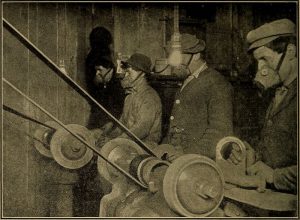Have you ever thought of murdering your sibling after an argument? Or does that seem a bit too extreme? Perhaps too understandable? Sisters! There is no greater bond like that of sisters, and even more so if they are twin sisters. Twins are fascinating, and the Gibbons twins, Jennifer and June, were no exception. The Gibbons twins’ closeness and companionship was startling to say the least, but their gift of having each other eventually turned into a curse.

Jennifer and June Gibbons were born on April 11, 1963, in Barbados, to Gloria and Aubrey Gibbons, and they grew up in Havenfordwest, Wales.1 Like most twins, the girls shared a tight bond; but their bond was even stronger than most. They only spoke to each other, using the few words that they knew. This characteristic of their relationship is what gave them the label Silent Twins. In their small town, they were the only black children in their school, which consequently led to their being bullied because of their race. These experiences only intensified their avoidance of communicating with anyone outside of their unique duo, which, according to the New Yorker journalist Hilton Als, “led to their emotional exile, their institutionalization, and…to the misguided appropriation of their story by activists and theorists who used it to pose questions about the nature of identity and the strange birthright that twins are forced to bear.”2
Soon after suffering from the bullying, the twins cut themselves off from others even further. They only spoke to each other in a unique language only they understood, and they began to refuse to do any school work or show any signs of productivity. The family then chose to move to Wales, and when the girls were enrolled in a school near the Haverfordwest community, which was known for intense racism, the bullying grew severe.3 From taunting them to pulling their hair, their schoolmates terrorized the girls constantly. Consequently, the sisters’ behavior grew to be even more odd, from synchronized walking to mirroring one another’s actions, as if they were the same person.4 Thereafter, a school nurse became intrigued with the sisters. School physician John Reed came to vaccinate the students, and upon giving June and Jennifer their shots, he noted that the girls did not even flinch. They just stood there lifeless. The nurse then reported this to the school. The school had been familiar with the strange behavior the girls were constantly exhibiting. Therefore, the sisters were sent to Haverfordwest Withybush Hospital in February 1977 for examination.5 Upon arriving at the hospital, the girls continued to not speak to anyone but to each other. The girls were then transferred to East Gate Special Education Center, which served as a boarding school. While at the center, Jennifer and June continued to isolate themselves. Consequently, they were separated in hopes of having the girls become independent from each other. Jennifer remained at East Gate, while June was sent thirty miles away to St. David’s Adolescent Unit. This had disastrous effects on the girls to the point of them becoming catatonic, where they would not eat or sleep until they were reunited.

When the girls turned sixteen, they were sent back home, where they spent several years refraining from interacting with anyone other than eachother. They used writing as a form of entertainment and found great passion in it. Eventually, the girls would enroll in a writing program as one person, hoping to become famous novelists. Their novels were never recognized, which fairly disappointed the girls. Upon turning eighteen, the sisters finally left their rooms and began a downward spiral from doing drugs to committing crimes and abusing one another. They were arrested after breaking a window and lighting a fire at a community college. Consequently, they were sent to Puckle Church Remand Center, where they stayed for seven months. While there, the girls wrote diaries about how much they hated each other and were scared of each other. In their diaries, they wrote about how lonely they were, but once reunited, they reverted to hating each other once again. They were diagnosed with psychopathic personality disorder, and were sent to Broadmoor Mental Hospital, where they were seen as very disturbed and violent. Eventually, after eleven years at Broadmoor, they were transferred to Caswell Clinic, another mental hospital.
At that time, the journalist Marjorie Wallace had become interested in the girls and began studying them. Jennifer had admitted to Wallace that she had to die in order for June to survive and thrive. The girls mentioned to Wallace that the day of their transfer would be the day Jennifer would have to die.6 They believed that they could not both function properly at the same time, while both of them were still living. This was the underlying cause for their strange behavior. In March 1993, at thirty-one years old, the girls were transferred to Caswell, but upon arrival, Jennifer was unresponsive. Jennifer was rushed to the hospital where she was pronounced dead, with the cause of death being a sudden inflammation of the heart. Jennifer died on the exact day the sisters had predicted, from bizarrely natural causes. June stated that when Jennifer was dying, her last words were “At last we’re out.”7
After Jennifer’s death, June left Caswell a year later and her life completely changed. She began speaking more and improving her social skills. It was as if their belief that only one could thrive was proven to be true. June then requested to be called by her middle name, Alison, to help with the reinvention of her whole identity. It would take June five years to accept Jennifer’s death, refrain from feeling guilty, and fully move on with her life, according to Marjorie Wallace.8

- Marjorie Wallace, The Silent Twins (United Kingdom: Vintage Publishing, 1996), 3-4. ↵
- Hilton Als, “We Two Made One,” New Yorker, December 2000. Accessed January 27,2018. https://www.newyorker.com/magazine/2000/12/04/we-two-made-one. ↵
- Hilton Als, “We Two Made One,” New Yorker, December 2000. Accessed January 27,2018. ↵
- Polly Teale, Speechless (London: Nick Hern Books, 2011), 14. ↵
- Hilton Als, “We Two Made One,” New Yorker, December 2000. Accessed January 27,2018. https://www.newyorker.com/magazine/2000/12/04/we-two-made-one ↵
- Marjorie Wallace, The Silent Twins (United Kingdom: Vintage Publishing, 1996), 270. ↵
- April de Angelis, “June Gibbons couldn’t mourn the death of her ‘silent twin’ Jennifer,” Guardian Newspaper, May 29, 1994. Accessed January 27, 2018. https://www.theguardian.com/books/2007/jun/28/fiction.classicalmusicandopera ↵
- Marjorie Wallace, The Silent Twins (United Kingdom: Vintage Publishing, 1996), 273. ↵



144 comments
Samire Adam
I am speechless after reading this article. I can’t imagine what life was like for both Jennifer and June coming to a foreign country and not having anyone else but each other. Moreover, the constant bullying they received from other kids might have left long-lasting phycological damage. They profession help they were receiving might have spoiled the strong bound the sister had with each other. The continuous separation and unification was not easy on their relationship and might have been the reason why they strongly believed that one of the sisters might have to die for the other to succeed in life.
Cristina Cabello
This is a really interesting article. I too have a sister and have never thought about murdering her. They way that you developed this article is similar to the columbine article. Both siblings were bullied. This really sets an aspect on how people need to treat others. You never know how people are feeling or what they are going through. Overall you did a good job!
Erin Vento
Everything surrounding the Silent Sisters is so strange and a little tragic (especially the racism they experienced as kids). All sisters fight no matter how close they are or were, but the whole thing about one sister having to die for the other and them still hating each other is so weird. Overall, it really is just a weird case, but a great article.
Carlos Vazquez
This is the second time I read this article because I think it so strange and interesting to read about. This is definitely one of the strangest things I have ever heard. The fact that she was able to predict how and when her sister would die is really creepy. This article is well written and I really enjoyed reading it.
Ximena Mondragon
This article is very interesting since the twins had their own kind of communication. However, it is sad that they had trough bullying for the color of their skin. They depended on each other as found safety in each other but that became a toxic relationship. I like how the article starts with very uncomfortable rhetorical questions.
Esperanza Mauricio
Twins have always been a fascinating topic. This case is so different from others I have read about. Because of bullying in early childhood they isolated themselves but because of that isolation they began to resent one and another. Or maybe it was because they could not be one person. They entered the writing contest under the same name but did not win, they later acted out. Maybe it caused them to realize the they couldn’t truly be one of the same and so could not continue their ways of isolation.
Robert Rodriguez
This was such an intriguing article to read, the fact that they developed their own ways of communication between each other and even got to the point where they were able to synchronize each others movements exactly alike is amazing. Its sad that these poor girls were bullied because of their skin color resulting and being excluded from society because of it. Its sad that they fell down such a horrible path and spent such a long time behind the doors of a mental hospital. the ending had me completely shocked, it seems like her theory of being normal if there was only one of them was correct but only for a short amount of time sadly…
Saira Castellanos
i have a sister and we are exactly 1 year and 3 months apart to the day. the first sentence of the article made me want to read more. What an extreme to want to kill your sibling. It is insane how close of a bond these sisters had and how they influenced each other. I cant imagine telling my sister that one of us has to die in order for the other to be happy. This article was kind of creepy. There are some really good introductions in the nominations, so good luck!
Johnanthony Hernandez
Interesting and well written article, while the fear that they held for each other was present they seemed to still have a bond that tied them together as siblings. Sibling rivalry can be a fearsome thing, but most siblings in modern history would not think that in order for them to be happy one must die. While those of us that have siblings we could not think that if we are to be happy that our sibling must die and that if it were to happen we would not feel happy as in this case.
Belia Camarena
I had already read this article, and it was just as good the second time around. The story of these sisters is incredible. The bond they shared was unlike no other; I can’t even imagine having a connection that strong with my sister. Nonetheless, the story of these two sisters is kind of eerie. They perfectly predicted the death of Jennifer, and I cannot think of any feasible way for this to happen other than murder. However, the autopsy came out clean, so I guess we will never know.